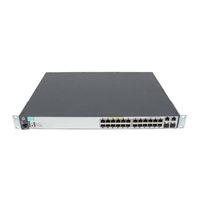ProCurve 3500yl Series Manuals
Manuals and User Guides for ProCurve 3500yl Series. We have 2 ProCurve 3500yl Series manuals available for free PDF download: Management And Configuration Manual
ProCurve 3500yl Series Management And Configuration Manual (732 pages)
Table of Contents
-
-
-
Contents33
-
Introduction34
-
-
-
Port Status105
-
The Alert Log106
-
The Status Bar108
-
-
Sessions
161 -
-
-
Been Inserted242
-
Poe Devices
253 -
-
Rate-Limiting
322-
Terminology329
-
Jumbo Frames
345-
Operating Rules346
-
Troubleshooting355
-
Contents357
-
Overview359
-
-
-
-
-
-
Terminology394
-
-
Contents
441
-
-
Overview443
-
-
-
Show Module463
-
Show Flash464
-
Show Redundancy464
-
Show Version465
-
Show Log466
-
-
-
Show Redundancy466
-
Show Flash467
-
Show Version467
-
-
-
-
Identity Page476
-
Overview Page477
-
Device View Page478
-
-
Logging Messages
481-
Log File481
-
Crash Files482
-
-
-
File Transfers
489-
Contents489
-
Overview
491 -
-
-
How It Works498
-
-
Workstation503
-
-
-
-
Contents531
-
Overview
534 -
-
-
Menu Access539
-
CLI Access540
-
-
Port Status543
-
CLI Access543
-
Web Access543
-
-
VLAN Information553
-
-
Terminology557
-
-
Operating Notes605
-
-
-
Troubleshooting
609-
Contents609
-
Overview
612 -
-
General Problems616
-
ACL Problems617
-
Fan Failure634
-
-
-
-
Debug Command657
-
Debug Messages657
-
-
Logging Command660
-
Diagnostic Tools
667-
DNS Resolver672
-
-
Advertisement
ProCurve 3500yl Series Management And Configuration Manual (638 pages)
Table of Contents
-
-
Overview
40 -
-
Port Status105
-
The Alert Log106
-
The Status Bar108
-
-
Sessions
157 -
-
-
Poe Devices
251 -
-
Rate-Limiting
314 -
Jumbo Frames
336 -
-
And Traps368
-
Operating Notes371
-
-
Terminology377
-
-
Contents
425
-
-
Overview427
-
-
How It Works434
-
Command Options437
-
Authentication438
-
-
Workstation
440 -
-
Workstation
456
-
-
-
Overview
463 -
-
CLI Access469
-
-
Terminology484
-
Operating Notes530
-
-
-
Troubleshooting
535-
Contents535
-
Overview
537 -
-
General Problems541
-
ACL Problems542
-
Fan Failure559
-
-
Diagnostic Tools
578-
DNS Resolver583
-
-
Contents609
-
-

